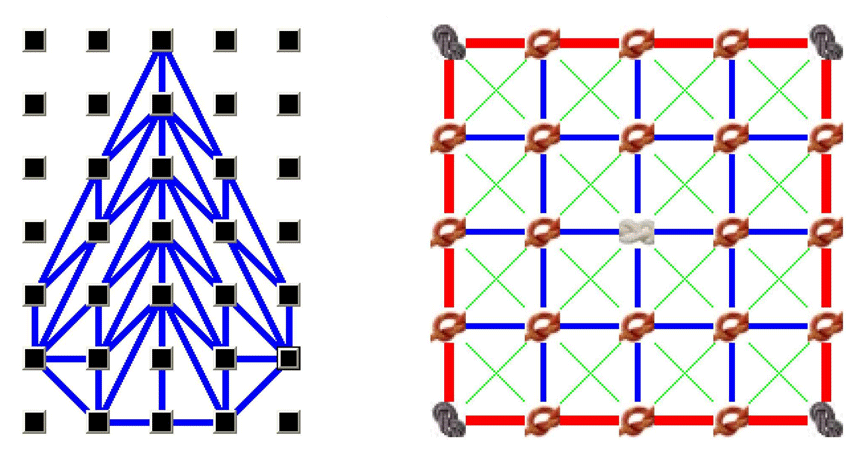Bigger groups make better tools
Living in large groups may propel the ability of people to create new and clever things

In lab experiments, volunteers learned to draw either arrowheads (left) or fishing nets (right). Tool designs improved when people could learn from others around them.
ISEM/CNRS
Share this:
- Share via email (Opens in new window) Email
- Click to share on Facebook (Opens in new window) Facebook
- Click to share on X (Opens in new window) X
- Click to share on Pinterest (Opens in new window) Pinterest
- Click to share on Reddit (Opens in new window) Reddit
- Share to Google Classroom (Opens in new window) Google Classroom
- Click to print (Opens in new window) Print
Many animals are smart. But people are uniquely so. When devising new tools, they usually improve on some earlier version. And each new tool can help make the designer’s entire community more effective at some task, like gathering food. A new study now links living in large groups with the development of more complex and effective tools.
In this case, the tools aren’t just those used for digging or building. The study’s authors suggest large groups also may have made possible the creation of tools like language, the Internet, even Instagram. A tool can be anything that helps people accomplish something.
People naturally learn from each other, picking up new skills. As the size of a community increases, so too does the frequency of new creations. That’s what Maxime Derex at the University of Montpellier 2 in France and his coworkers report in the Nov. 13 Nature. An evolutionary biologist, Derex studies how social learning has shaped human culture. Culture describes the way of life of a group of people. It can include, for example, the arts, tools and social institutions like government.
Derex’s team invited 366 male college students to take part in some tests. The scientists divided the men into groups — or teams — of 2, 4, 8 or 16 individuals. Each recruit started by watching a short video. It described how to make a tool, either an arrowhead (as for a spear) or a fishing net. Then each player logged onto a video game and tried to draw an arrowhead or net.
Each student played the game 15 times. During each round, the recruits could choose to draw either type of tool. The game analyzed each newly designed arrowhead or net to predict how much food it could capture for its designer and then gave the tool a score. Following each round, all of the players got to see their teammates’ designs and scores. Then each recruit was given the chance to modify his tool’s design to try to make it more effective.
The two largest groups designed the best tools, Derex’s team found. Most players started by drawing tools that were less effective than those shown in the video. But in teams of 8 or 16, the players’ final tools were as good as or better than the video’s examples.
Derex notes that those two biggest groups achieved roughly equal levels of success. That suggests the tool-building benefits of a large group may taper off at some group size (at least in the lab).
Joseph Henrich is an anthropologist at the University of British Columbia in Vancouver who did not work on the new study. He says the new findings may help researchers better understand life during the Stone Age. For part of that ancient period, which includes much of human history, people coexisted with humanlike Neandertals. But Neandertals lived in smaller groups than ancient humans did, Henrich notes. Hanging out in larger communities may have given humans a creative advantage. Some scientists say that Stone Age humans made more effective tools than Neandertals, who eventually went extinct.
The take-home message, Henrich told Science News, is that it now appears “it’s better to be social than smart.”
Power Words
anthropology The study of humankind. A social scientist who studies different societies and cultures is called an anthropologist.
culture The customs, arts, social institutions and achievements of a particular nation, people or other social group.
evolutionary biologist Someone who studies the adaptive processes that have led to the diversity of life on Earth. These scientists can study many different subjects, including the microbiology and genetics of living organisms, how species change to adapt, and the fossil record (to assess how various ancient species are related to each other and to modern-day relatives).
extinct No longer in existence, as in a species or larger group of organisms.
Neandertal (formerly spelled Neanderthal) This hominid species (Homo neanderthalensis) lived in Europe and parts of Asia from about 200,000 years ago to roughly 28,000 years ago.
population A group of individuals from the same species that live in the same area.
Stone Age A prehistoric period, lasting millions of years and ending tens of thousands of years ago, when weapons and tools were made of stone or of materials such as bone, wood, or horn.
tool A thing that performs a specific function, used to achieve a specific purpose. Tools include conventional items such as a hammer as well as things like language and the Internet.







